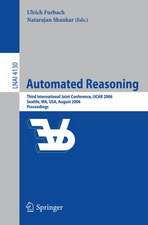Building Knowledge-Based Systems for Natural Resource Management
Autor Daniel L. Schmoldt, H. Michael Rauscheren Limba Engleză Hardback – 31 mar 1996
| Toate formatele și edițiile | Preț | Express |
|---|---|---|
| Paperback (1) | 950.03 lei 6-8 săpt. | |
| Springer Us – 16 sep 2011 | 950.03 lei 6-8 săpt. | |
| Hardback (1) | 956.18 lei 6-8 săpt. | |
| Springer Us – 31 mar 1996 | 956.18 lei 6-8 săpt. |
Preț: 956.18 lei
Preț vechi: 1166.08 lei
-18% Nou
Puncte Express: 1434
Preț estimativ în valută:
183.02€ • 198.87$ • 153.84£
183.02€ • 198.87$ • 153.84£
Carte tipărită la comandă
Livrare economică 21 aprilie-05 mai
Preluare comenzi: 021 569.72.76
Specificații
ISBN-13: 9780412019210
ISBN-10: 0412019213
Pagini: 386
Ilustrații: XXII, 386 p.
Dimensiuni: 155 x 235 x 24 mm
Greutate: 0.75 kg
Ediția:1996
Editura: Springer Us
Colecția Springer
Locul publicării:New York, NY, United States
ISBN-10: 0412019213
Pagini: 386
Ilustrații: XXII, 386 p.
Dimensiuni: 155 x 235 x 24 mm
Greutate: 0.75 kg
Ediția:1996
Editura: Springer Us
Colecția Springer
Locul publicării:New York, NY, United States
Public țintă
ResearchCuprins
1 AI and Natural Resource Management.- 1.1 Natural Resources.- 1.2 Resource Management.- 1.3 Knowledge: A Historical Framework.- 1.4 Artificial Intelligence.- 1.5 Knowledge-Based Systems.- 1.6 Some Potential Benefits of Knowledge-Based Systems.- 1.7 Limitations of Knowledge-Based Systems.- 1.8 Suitable Application Areas.- 1.9 Summary.- 2 Knowledge-Based Systems: Representation and Search.- 2.1 An Overview of KBS Organization.- 2.2 The Knowledge Base and Knowledge Representation.- 2.3 Working Memory.- 2.4 Search: Inference and Control.- 2.5 Knowledge-Based System Architectures.- 2.6 Summary and Additional Readings.- 3 Other Knowledge System Components.- 3.1 Explanation and Justification.- 3.2 User Interface.- 3.3 Learning Capabilities.- 3.4 Interfacing to Conventional Programs and Data Files.- 3.5 Inexact Reasoning and Uncertainty.- 3.6 Summary and Additional Readings.- 4 Planning the Application.- 4.1 Parallelism and Cycling in the Development Process.- 4.2 Alternative Development Methods.- 4.3 Problem Definition.- 4.4 Summary.- 5 Knowledge Acquisition.- 5.1 Knowledge Acquisition in Overview.- 5.2 Surface Versus Deep Knowledge.- 5.3 Knowledge Acquisition Strategies.- 5.4 Creating a Domain Ontology.- 5.5 Acquisition Methods.- 5.6 Domain Ontology and Acquisition Methods.- 5.7 Knowledge Acquisition Scenarios.- 5.8 Knowledge Acquisition Guidelines.- 5.9 Expert Biases and Eliciting Uncertain Knowledge.- 5.10 Summary and Additional Readings.- 6 Designing the Application.- 6.1 Application Design = Knowledge Model + Human Factors Model.- 6.2 Pre-Implementation Topics.- 6.3 Prototyping.- 6.4 Summary.- 7 Programming Knowledge Systems in Prolog.- 7.1 Why Prolog?.- 7.2 Introduction to Prolog.- 7.3 Summary and Additional Readings.- 8 An Initial Prototype Using Native PROLOG.- 8.1 Knowledge-Based System Architecture.- 8.2 The Domain Level.- 8.3 The Tactical Control Level.- 8.4 System Control Level.- 8.5 Putting It All Together.- 8.6 From Native Prolog to Meta-PROLOG Programming.- 8.7 Summary.- 9 A PROLOG Toolkit Approach to Developing Forest Management Knowledge-Based Systems.- 9.1 A KBS Toolkit.- 9.2 DSSTOOLS System Architecture.- 9.3 Domain Level.- 9.4 Tactical Control Level.- 9.5 System Control Level.- 9.6 Summary.- 10 System Evaluation and Delivery.- 10.1 System Evaluation.- 10.2 Delivery.- 10.3 Summary.- Appendix A Roots of Artificial Intelligence.- A.1 A Definition of Artificial Intelligence.- A.2 Dreams of Intelligent Artifacts.- A.2.1 Ancient Dreams.- A.2.2 Modern Nightmares.- A.3 Realization.- A.3.1 Realize What?.- A.3.2 Mind as a Tool.- A.4 Knowledge.- A.4.1 Group Knowledge.- A.4.2 Hierarchical Structure.- A.4.3 Chunks.- A.4.4 Representation of Chunks.- A.4.4.1 Frames and Semantic Networks.- A.4.4.2 State Space.- A.4.4.3 Artificial Neural Networks.- A.4.4.4 Rules.- A.4.4.5 Threaded Chunks.- A.5 Goals.- A.6 Reaching the Goal.- A.6.1 Generate-and-Test.- A.6.2 Goal Reduction.- A.6.3 State-Space Search.- A.6.4 Genetic Algorithms and Emergent Behavior.- A.7 Interfacing, or Conversing with the Statue.- A.8 Testing and Conclusion.- Biliography.

















